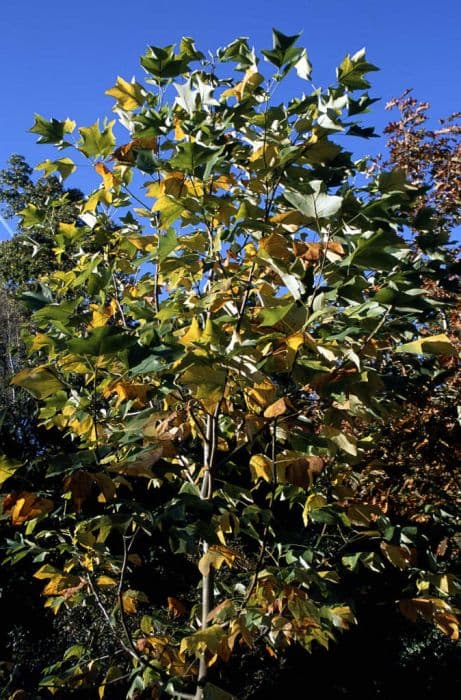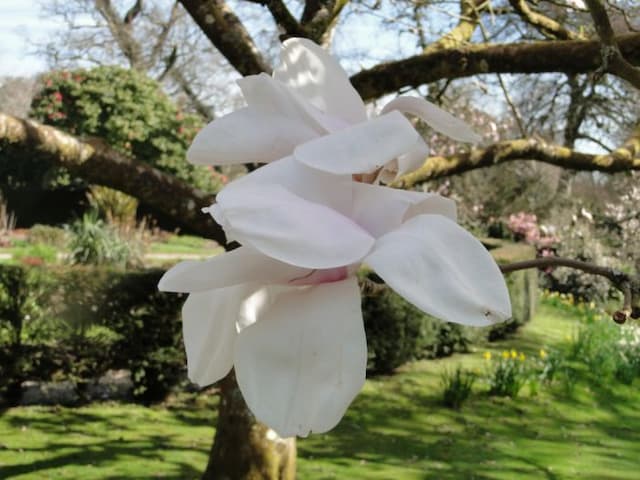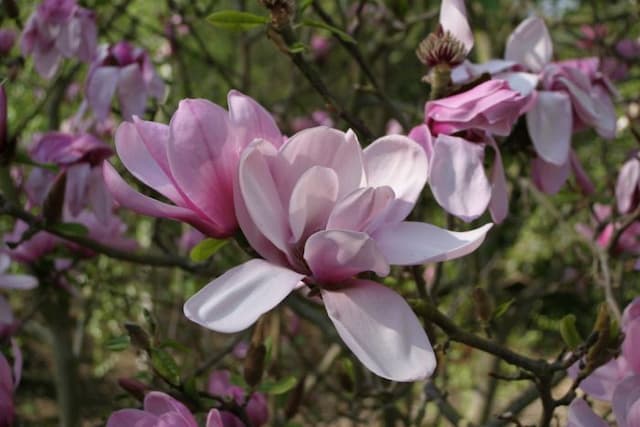Magnolia Magnolia 'Joe McDaniel'

ABOUT
The Magnolia 'Joe McDaniel' is a flowering plant known for its striking, large blooms. The flowers are typically a rich purple-pink on the outside with paler interiors, often white or creamy in coloration. These cup-shaped blossoms emit a delightful fragrance that is both sweet and subtle, adding to the sensory appeal of the plant. The leaves of Magnolia 'Joe McDaniel' are glossy and dark green, providing a lush backdrop for the spectacular flowers. They are broad and can be quite leathery in texture, contributing to the plant's robust appearance. The leaves are elongated, often with a pointed tip, and they have a smooth margin that outlines the leaf's shape. As the seasons change, Magnolia 'Joe McDaniel' displays a transition in its appearance. In spring, the flowers emerge on the bare branches before the leaves develop, creating a dramatic floral display. As the flowering season concludes, the plant remains visually appealing with its verdant foliage. In addition to its visual beauty, the structure of the Magnolia 'Joe McDaniel' is quite substantial. It has a sturdy branching pattern that provides strong support for the generous blooms. The bark of the tree is typically a grayish color, with a texture that can vary from smooth in its youth to more furrowed and textured as the plant matures. Overall, Magnolia 'Joe McDaniel' is admired for its aesthetic qualities, with the magnificent blooms being the focal point that draws the most attention and admiration.
About this plant
 Names
NamesSynonyms
Joe McDaniel Magnolia, Joe McDaniel's Magnolia
Common names
Magnolia 'Joe McDaniel'.
 Toxicity
ToxicityTo humans
Magnolias, including the Magnolia 'Joe McDaniel', are not typically considered toxic to humans. However, as with any plant, individual allergic reactions or sensitivities are possible. If large quantities of the plant are ingested, it could potentially cause stomach upset, nausea, or vomiting due to the plant’s natural compounds. But in general, magnolias are considered safe and not poisonous to humans when touched or ingested in small amounts.
To pets
Magnolias, such as the Magnolia 'Joe McDaniel', are also generally considered non-toxic to pets. There could be mild gastrointestinal upset if a pet ingests large amounts of the leaves or flowers, such as vomiting or diarrhea, but magnolias are not known for being seriously poisonous to animals. As always, it is best to keep an eye on your pet and prevent them from eating plants, as individual animals may have different sensitivities.
 Characteristics
CharacteristicsLife cycle
Perennials
Foliage type
Deciduous
Color of leaves
Green
Flower color
Pink
Height
20 feet 6 meters [6.10]
Spread
15 feet (4.6 meters)
Plant type
Tree
Hardiness zones
5
Native area
North America
Benefits
 General Benefits
General Benefits- Aesthetic Appeal: Offers vibrant, large flowers that are a visual highlight in any landscape.
- Spring Interest: Blooms profusely in spring, providing early seasonal color.
- Fragrance: The flowers emit a pleasant, sweet scent that can enhance the sensory experience of a garden.
- Attracts Wildlife: The blossoms attract pollinators like bees and butterflies, supporting local ecosystems.
- Shade Production: As a larger tree, it provides shade which can help in cooling surrounding areas.
- Longevity: Once established, it is a long-lived tree providing benefits for many years.
- Low Maintenance: Requires minimal pruning and upkeep once established.
- Drought Tolerance: Mature trees can tolerate periods of drought, reducing the need for frequent watering.
- Year-round Interest: Besides flowers, the tree offers attractive foliage, and some forms may exhibit interesting bark patterns.
 Medical Properties
Medical Properties- This plant is not used for medical purposes.
 Air-purifying Qualities
Air-purifying QualitiesThis plant is not specifically known for air purifying qualities.
 Other Uses
Other Uses- The wood of Magnolia trees can be used for furniture making, offering a light, fine-grained resource for cabinetry and intricate woodworking.
- Dried Magnolia petals can be incorporated into potpourri blends for a natural, floral fragrance that can freshen up living spaces.
- Magnolia blossoms can be used to make a sweet-smelling, homemade perfume by infusing the petals in a carrier oil.
- Young, tender Magnolia leaves can be used in floral arrangements, providing a glossy, deep green backdrop for colorful flowers.
- The bark and branches of Magnolia trees can be crafted into rustic home decor items such as wreaths or wall hangings.
- Thick Magnolia leaves can be utilized as natural mulch in garden beds to retain soil moisture and suppress weeds.
- Magnolia seed pods can be used in craft projects, as they offer interesting shapes and textures for decorative purposes.
- The sturdy wood of Magnolia is sometimes used in the construction of musical instruments, like some parts of guitars, for its tonal qualities.
- Pressed Magnolia flowers can be used in art projects, such as creating botanical prints or in resin jewelry for a unique aesthetic.
- The large, leathery leaves of Magnolia can be used as a natural wrapping material for small gifts or homemade soaps.
Interesting Facts
 Feng Shui
Feng ShuiThe Magnolia is not used in Feng Shui practice.
 Zodiac Sign Compitability
Zodiac Sign CompitabilityThe Magnolia is not used in astrology practice.
 Plant Symbolism
Plant Symbolism- Perseverance and Endurance: The Magnolia 'Joe McDaniel' is known for its strength and ability to withstand harsh conditions, symbolizing one's ability to endure challenges and persist through difficult times.
- Nobility: Magnolias are often associated with dignity and splendid beauty, conveying an air of elegance and a noble spirit.
- Femininity and Beauty: The delicate and graceful appearance of the magnolia flowers often represents femininity, softness, and the beauty of womanhood.
- Purity and Innocence: The pure white flowers of some Magnolia 'Joe McDaniel' variants signify cleanliness, innocence, and honesty, often used in ceremonial contexts to convey these qualities.
- Peace and Tranquility: Featuring in many gardens and spaces as a calming presence, magnolias can symbolize the search for peace and harmony in one's life.
 Water
WaterThe Magnolia 'Joe McDaniel' should be watered deeply to encourage deep root growth, which typically means applying water until it penetrates several inches into the soil. In general, this plant prefers a consistently moist soil and should be watered once a week with about 1.5 to 2 gallons of water, but this schedule might be adjusted during hot and dry periods to twice a week or during rainy conditions to less or not at all. It is important to avoid overwatering as it can lead to root rot, especially in poorly drained soils, so let the soil dry out slightly between waterings. During winter, you can reduce the frequency significantly as the plant's water needs decrease.
 Light
LightThe Magnolia 'Joe McDaniel' grows best in full sun to partial shade. It thrives when it receives at least four hours of direct, unfiltered sunlight per day, but it will tolerate some shade, especially in the hotter parts of the day. A location where it can enjoy morning sunlight with some afternoon protection is ideal for preventing leaf scorch in areas with intense afternoon sun.
 Temperature
TemperatureThe Magnolia 'Joe McDaniel' prefers temperate climates and is hardy in a range of temperatures, able to withstand minimum winter temperatures down to about 0 degrees Fahrenheit. The ideal growing temperatures for this magnolia are between 70 and 85 degrees Fahrenheit during the growing season. It can survive up to temperatures in the lower 90s, but prolonged exposure to extremes outside of this range may stress the plant.
 Pruning
PruningPruning the Magnolia 'Joe McDaniel' is done to shape the tree, remove dead or diseased wood, and encourage healthy growth and airflow. The best time for pruning is in late winter or early spring, before new growth begins, as this helps to prevent bleeding of sap which can attract pests. Pruning should be done sparingly, as the tree can be slow to recover from heavy cutting. Always use clean, sharp tools for precise cuts.
 Cleaning
CleaningAs needed
 Soil
SoilThe best soil mix for growing a Magnolia 'Joe McDaniel' is well-draining, rich in organic matter, and slightly acidic to neutral, with a pH range of 5.5 to 7.0. A blend of loamy soil, compost, and pine bark would be ideal to promote healthy growth.
 Repotting
RepottingMagnolia 'Joe McDaniel' trees, once established, typically do not require frequent repotting. Repot young trees every 2 to 3 years to encourage growth, but mature trees can remain in the same spot without repotting unless showing signs of stress.
 Humidity & Misting
Humidity & MistingMagnolias, including 'Joe McDaniel', prefer average to high humidity levels. While they do not require tropical humidity, they benefit from a moist environment that mimics their native habitat.
 Suitable locations
Suitable locationsIndoor
Provide bright, indirect light and rotate periodically.
Outdoor
Full sun to partial shade; protect from harsh conditions.
Hardiness zone
5-9 USDA
 Life cycle
Life cycleThe life of a Magnolia 'Joe McDaniel', also known as a Magnolia, begins with seed germination, which occurs best when the seeds are sown fresh and subjected to warm-cold stratification to break dormancy. Seedlings then grow into juvenile plants, which focus on establishing root systems and putting on vegetative growth. As the Magnolia matures, it enters the vegetative stage, developing its characteristic large, glossy leaves and woody stems. After reaching maturity, which can take several years, the tree starts producing its large, fragrant flowers, usually from late winter to early spring, signaling the start of the reproductive stage. Following pollination, typically by bees, the flowers develop into cone-like fruit that releases seeds when mature. Finally, the tree enters a period of senescence as it ages, which can lead to reduced flowering and eventual death, typically after many decades.
 Propogation
PropogationPropogation time
Spring-Early Summer
The Magnolia 'Joe McDaniel', a variety of tulip tree, is commonly propagated through the method of grafting. Grafting involves joining the tissues of the Magnolia 'Joe McDaniel' with a compatible rootstock to ensure that the resulting plant possesses the characteristics of the 'Joe McDaniel' variety. This process is typically performed during the dormant season, often in late winter to early spring. To graft, a small branch or bud from the 'Joe McDaniel' magnolia is spliced onto the rootstock with a clean cut that matches a cut on the receiving stock. The two are then secured together using grafting tape or a similar material to hold the graft in place until it heals and the tissues fuse together, a process which may take several weeks to months depending on the conditions.









![Magnolia [Felix Jury]](/_next/image?url=https%3A%2F%2Fplants-admin.emdemapps.com%2Fimages%2Fplants%2F%2Fimages%2F604b61a0b23b7.png&w=640&q=75)